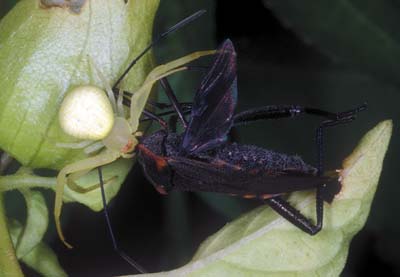
Misumenops oblongus, a crab spider, feasting on prey.
(Photographer: Lyle Buss, University of Florida)
Crab spiders resemble tiny crabs; the front pairs of legs are thicker and longer than the back pairs, and extend beyond the sides of their flattened bodies. Like crabs, these spiders also move sideways and backwards more easily than forwards. Crab spiders also are called "flower spiders" because they generally hunt in the flowers of various plants. They are active day hunters that do not spin webs to trap prey but wait motionless on flowers and leaves to ambush unsuspecting pollinators.
Males and females of the same species are similar in appearance. The lateral eyes of crab spiders often are larger than the median ones and located on tubercles. Many species are brightly colored - white, yellow, orange or even a pale greenish; others are drab colored to blend in with bark or soil. Some species in the genus Misumenops can change color over several days, depending on the color of the substrate upon which they rest. Males are generally active from May to August; females from July to September. Females lay their eggs in the fall and the young spiderlings (immatures) hatch the following spring. Most species of crab spiders live less than one year.
There are over 140 species of crab spiders found throughout the United States and Canada.
These spiders feed on bees, flies and other small flower-visiting arthropods.
Images
To save the Web-optimized images shown below to your hard drive:
|
Click to access Display and Print quality images. |